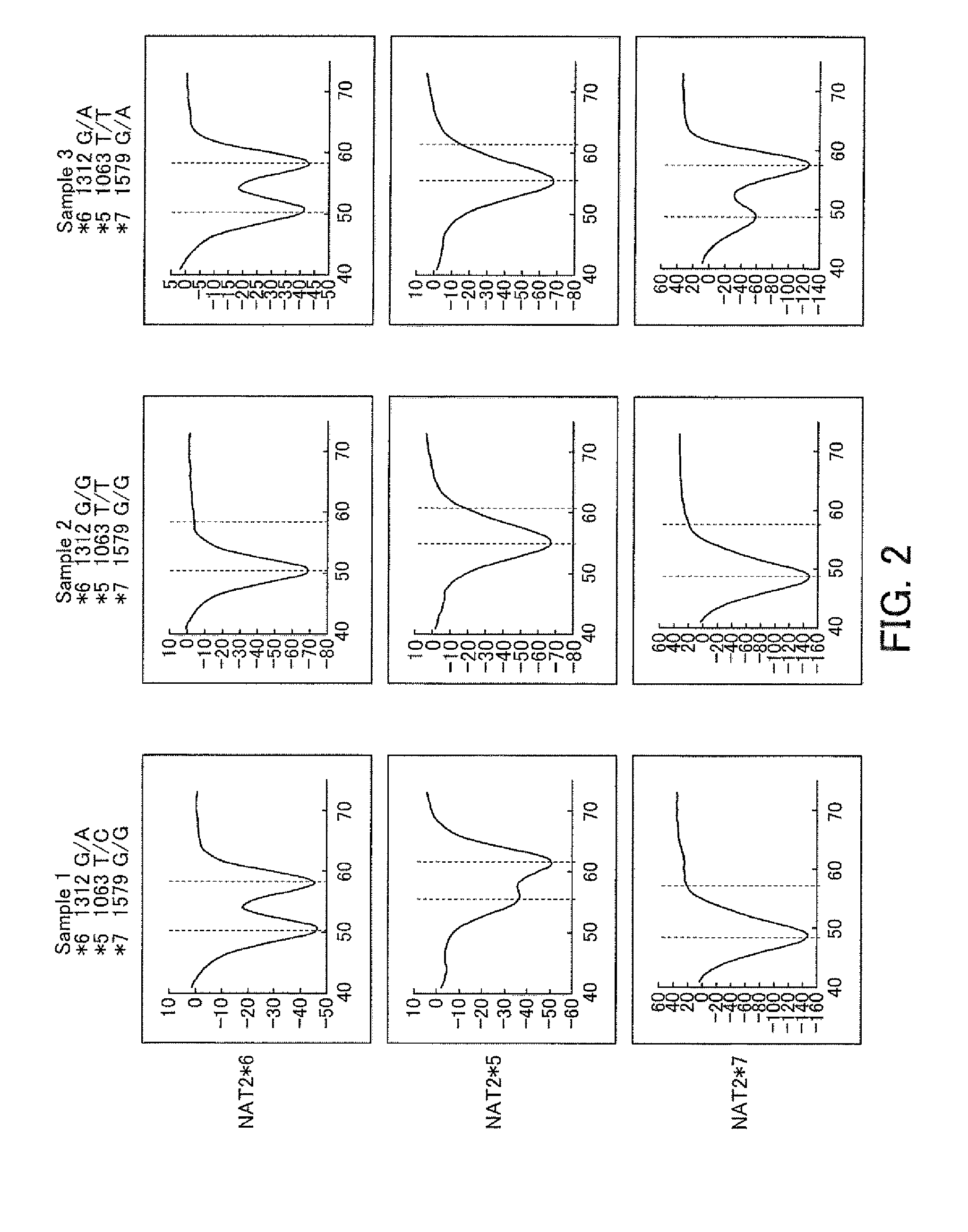Probes for Detection of NAT2 Gene, Reagent Containing the Same, and The Uses Thereof
a technology of nat2 gene and probe, which is applied in the field of probe for detection of nat2 gene, reagent containing the same, can solve the problems of affecting analysis accuracy, affecting the efficiency of amplifying a target region, and affecting the accuracy of analysis, so as to reduce time and cost, efficient amplify a target region, and automate the effect of operation
- Summary
- Abstract
- Description
- Claims
- Application Information
AI Technical Summary
Benefits of technology
Problems solved by technology
Method used
Image
Examples
example 1
[0142]Blood was collected from four subjects using heparin lithium blood collection tubes (Samples 1 to 4). Subsequently, 10 μL of blood thus obtained and 90 μL of distilled water were mixed together. Further, 10 μL of this mixture and 90 μL of distilled water were mixed together. Thereafter, 10 μL of the mixture was added to 40 μL of PCR reaction solution having the following composition, and then PCR was performed using a thermal cycler. Conditions for PCR were as follows. That is, after treating at 95° C. for 60 seconds, one cycle of treatment at 95° C. for 1 second and at 60° C. for 10 seconds was repeated for 50 cycles, and further it was treated at 95° C. for 1 second and at 40° C. for 60 seconds. Subsequently, the PCR reaction solution was heated from 40° C. to 95° C. at a rate of temperature rise of 1° C. / 3 seconds, and the change in fluorescence intensity over time was measured. The measurement wavelength was 450 to 480 nm (for detection of the fluorescent dye, Pacific Blue...
example 2
[0147]Blood was collected from three subjects using EDTA blood collection tubes (Samples 1 to 3). Subsequently, 10 μL of blood thus obtained and 70 μL of diluent A described below were mixed together. Further, 10 μL of this mixture and 70 μL of diluent B described below were mixed together. Subsequently, 10 μL of the mixture thus obtained was heat-treated at 95° C. for five minutes. Thereafter, this was added to 46 μL of PCR reaction solution having the following composition, and then PCR was performed using a thermal cycler. Conditions for PCR were as follows. That is, after treating at 95° C. for 60 seconds, one cycle of treatment at 95° C. for 1 second and at 65° C. for 15 seconds was repeated for 50 cycles, and further it was treated at 95° C. for 1 second and at 40° C. for 60 seconds. Subsequently, the PCR reaction solution was heated from 40° C. to 75° C. at a rate of temperature rise of 1° C. / 3 seconds, and the change in fluorescence intensity over time was measured. The meas...
PUM
| Property | Measurement | Unit |
|---|---|---|
| melting temperature Tm | aaaaa | aaaaa |
| pH | aaaaa | aaaaa |
| absorption wavelength | aaaaa | aaaaa |
Abstract
Description
Claims
Application Information
 Login to View More
Login to View More - R&D
- Intellectual Property
- Life Sciences
- Materials
- Tech Scout
- Unparalleled Data Quality
- Higher Quality Content
- 60% Fewer Hallucinations
Browse by: Latest US Patents, China's latest patents, Technical Efficacy Thesaurus, Application Domain, Technology Topic, Popular Technical Reports.
© 2025 PatSnap. All rights reserved.Legal|Privacy policy|Modern Slavery Act Transparency Statement|Sitemap|About US| Contact US: help@patsnap.com


